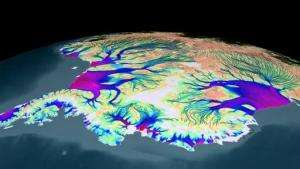Ice stream



A fast-moving ice or ice stream is a region of an ice sheet that moves significantly faster than the surrounding ice. Ice streams are a type of glacier.[2] They are significant features of the Antarctic where they account for 10% of the volume of the ice. They are up to 50 km wide, 2 km thick, can stretch for hundreds of kilometres, and account for most of the ice leaving the ice sheet.
The speed of an ice stream can be over 1,000 metres per year, an order of magnitude faster than the surrounding ice. The shear forces at the edge of the ice stream cause deformation and recrystallization of the ice, making it softer, and concentrating the deformation in narrow bands or shear margins. Crevasses form, particularly around the shear margins.
Most ice streams have some water at their base, which lubricates the flow. The type of bedrock also is significant. Soft, deformable sediments result in faster flow than hard rock.[3]
Antarctica
See also: List of Antarctic ice streams
The Antarctic Ice Sheet is drained to the sea by several ice streams. The largest in East Antarctica is Lambert Glacier. In West Antarctica the large Pine Island and Thwaites Glaciers are currently the most out of balance, with a total net mass loss between them of 85 gigatonnes per year measured in 2006.[4]
It has been suggested that the Antarctic ice sheet is losing mass. The past and ongoing acceleration of ice streams and outlet glaciers is considered to be a significant, if not the dominant cause of this recent imbalance.[4]
Greenland
Ice streams that drain the Greenland ice sheet into the sea include Helheim Glacier, Jakobshavn Isbræ and Kangerdlugssuaq Glacier.
References
- ↑ Bamber J.L., Vaughan D.G., Joughin I. (2000). "Widespread complex flow in the interior of the Antarctic Ice Sheet". Science 287 (5456): 1248–1250. Bibcode:2000Sci...287.1248B. doi:10.1126/science.287.5456.1248. PMID 10678828.
- ↑ National Snow and Ice Data Centre. "Types of Glacier".
- ↑ British Antarctic Survey. "Description of Ice Streams". Retrieved 2009-01-26.
- 1 2 Rignot, E.; Bamber, J. L.; Van Den Broeke, M. R.; Davis, C.; Li, Y.; Van De Berg, W. J.; Van Meijgaard, E. (2008). "Recent Antarctic ice mass loss from radar interferometry and regional climate modelling". Nature Geoscience 1 (2): 106. Bibcode:2008NatGe...1..106R. doi:10.1038/ngeo102.